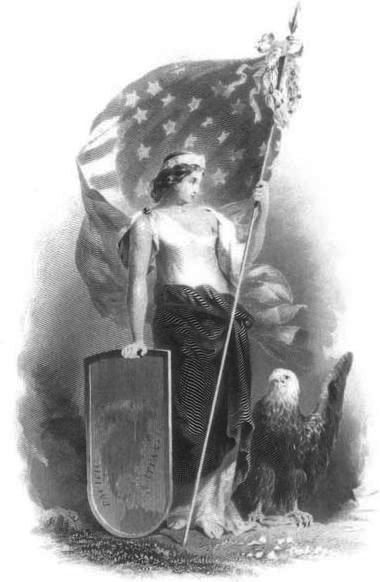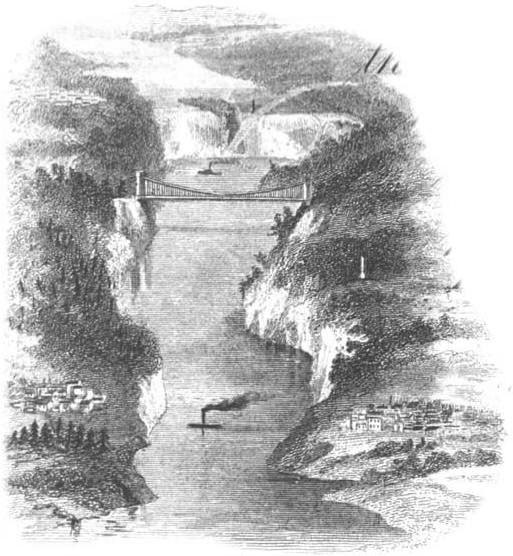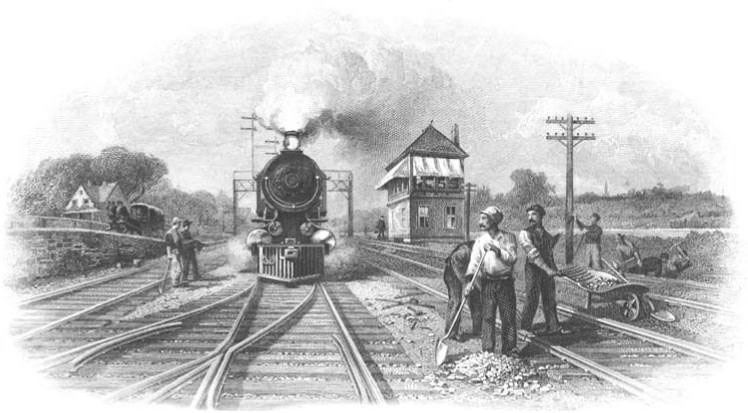
Format change for the third edition
It has always bothered me that finding specific certificates among heavily-populated companies is difficult in both the 1st and 2nd editions of my catalog. It is hard enough for me. It is harder for collectors who use the book and harder still for online users.
So, I will slightly modify the layout for the next edition, planned for the end of next year. The new layout will be a cross between the current textual format and the “Quickfind” charts.
The concept is to first list certificates within each company by their most obvious features – vignettes. Below the description of each vignette will be further subdivisions, as appropriate, based on less and less obvious features.
 One of THE classic images of Standing Liberty, engraved by the American Bank Note Company. This vignette appears on rare (and under-priced) specimens of the Union Pacific Railway Co from the 1880s. (Image from 1976 ABNCo Annual Report.)
One of THE classic images of Standing Liberty, engraved by the American Bank Note Company. This vignette appears on rare (and under-priced) specimens of the Union Pacific Railway Co from the 1880s. (Image from 1976 ABNCo Annual Report.)
The concept is a taxonomic approach. Taxonomic charts are used in biology and botony because every group of organisms is different and requires its own separate classification system. Characteristics found in one group are not necessarily shared by others.
The same is true with railroad companies. Every company took different approaches to corporate organization and fund raising. Therefore, companies printed their certificates in ways peculiar to their unique corporate needs.
The taxonomic approach allows stock certificates from one company to be grouped first by vignette, then par value, then printed date, and finally denomination. With another company, a better approach will be to array certificates first by vignette, then printer, then paper color. The variations are enormous.
Don’t jump to conclusions. This will not be a radical change. The information will not change. Numbers will stay the same. Rather, it will be a slightly different organizational structure that will allow readers to find items quicker and more reliably.
See an example of the new layout at http://www.coxrail.com/2006.pdf. The example shows all certificates from the New York Central, the most heavily-populated company in the database.
Switching to the new scheme will take six to eight months, requiring a re¬write of every description in the database. So far, I have about 10% finished. The new layout allows for cleaner, less redundant descriptions. In the last edition, there were thousands of listings that started with “same, but...” or “same as ...”. All those descriptions will become obsolete.
The new layout will create substantial space savings among heavily populated companies. It is too early to be sure, but on average, it appears the overall space occupied by each certificate description will drop slightly.
Census — 236 new varietie since December
|
December
letter |
This
letter |
| Number of certificates listed (counting all variants of issued, specimens, etc.) |
19,975 |
20,317 |
| Number of distinct certificates known |
15,202 |
15,438 |
| Number of certificates with celebrity autographs |
1,489 |
1,497 |
| Number of celebrity autographs known |
325 |
326 |
| 25,021 |
25,021 |
25,080 |
| Number of companies for which at least one certificate is known |
6,508 |
6,601 |
| Serial numbers records |
66,662 |
68,893 |
Lack of time forcing changes
 View of the Niagara River Gorge, replete with a RAINBOW! below the falls. This 2” tall vignette was engraved by Rawdon Wright & Hatch. It appears on New-York Central Rail Road Company bonds from 1853.
View of the Niagara River Gorge, replete with a RAINBOW! below the falls. This 2” tall vignette was engraved by Rawdon Wright & Hatch. It appears on New-York Central Rail Road Company bonds from 1853.
There was no newsletter last quarter, mainly because of time. Most of my regular contributors know that my lack of time has become an extreme concern. You know it’s bad when I can’t even find time to write the newsletter.
I receive so many inquiries and contributions that I have had to make adjustments. I am approaching “burn-out.” I have no free time. Most weeks, I spend 35 to 45 hours on stocks and bonds, above and beyond my regular work.
That must stop.
Priorities. The first step was to devise a system of priorities. It tells me which information to handle and which information to drop. I don’t want to upset any contributors, but I simply cannot handle it all.
My entire list of priorities, and explanations, are online at http://www.coxrail.com/priorities.htm.
As always, correspondence with my regular contributors gets highest priority. Time-consuming tasks and off-topic inquiries get lowest priority.
There are two major changes I need my newsletter readers to become aware of.
No more links. I no longer have the time to follow links of any sort. I want you to know that I deeply appreciate your thinking of me when you see items for sale on eBay. It is really quite flattering. I am honored that you will take your time to let me know.
 An ever-popular image of a steam locomotive approaching trackworkers. Eleven people are visible, including the driver in a horse-drawn buggy in the left distance. This vignette is from 1907 bonds of The Michigan Central Railroad Company, engraved by American Bank Note Co.
An ever-popular image of a steam locomotive approaching trackworkers. Eleven people are visible, including the driver in a horse-drawn buggy in the left distance. This vignette is from 1907 bonds of The Michigan Central Railroad Company, engraved by American Bank Note Co.
I am grateful. But, I’m going under!
Consequently, I will no longer follow links, including links to eBay sales.
I fully realize that some of you send only one link every few weeks. That one link may actually be quite helpful. But, please understand that I might receive over 100 links a week. Handling links sometimes takes a quarter of my time. Links are my single most time-intensive source of information. Henceforth, I will ignore all links. (Please, send images, final sell prices, and important details instead of links.)
Serial number lists. The second most time-consuming sources of information are lists of serial numbers. Again, the problem is not one or two numbers. It is large lists. Large collections of numbers usually come from eBay sales. Those listings create big problems with mis-reported serial numbers and dates. There are too many cheap certificates and listings are too ephemeral. There is no opportunity for troubleshooting and I cannot possibly confirm whether out-of-sequence numbers represent new varieties. Or mistakes.
Unfortunately, those innocent mistakes persist for years.
Sadly, some people send lists that include only serial numbers and company names. Without images, catalog numbers, or other information, I cannot possibly attribute numbers to varieties in any reasonable amount of time. Believe me, serial numbers are not worth that trouble.
Don’t get me wrong. I DO want serial numbers. So, I ask for one minor change.
If you are going to send serial numbers, they must come from YOUR collection. That way, when something curious appears (and it always does), I can write you for clarification. Groups of numbers from multi-item accumulations are particularly helpful, because I can enter them all at once.
Off-topic inquiries. The good thing is, one area of wasted time has improved dramatically. The subject of off-topic inquiries is an area of guarded success. I used to receive 20 to 40 off-topic inquiries per week. After I changed the way people send email from my web site, only one or two off-topic inquiries slip through each month.
Typical off-topic inquiries include:
- non-railroad certificates
- obsolete currency
- bogus parchment-paper “currency”
- coupons
- engraving companies
- corporate histories
- assignment of CUSIP numbers
 Eleven people are also visible in this American Bank Note Company vignette that appears on 1944 bonds of The Pittsburgh Cincinnati Chicago & St Louis Railroad Co. This is the only image I can remember that shows workers bending rails.
Eleven people are also visible in this American Bank Note Company vignette that appears on 1944 bonds of The Pittsburgh Cincinnati Chicago & St Louis Railroad Co. This is the only image I can remember that shows workers bending rails.
A simple measurement for rare, scarce, and common
I see it all the time. People who seem to think that everything they touch is rare simply because they own it! At least, that seems to be what they are claiming in eBay sales.
It is one thing if a beginner unknowingly overstates rarity. It is an entirely different matter when a seller exaggerates rarity in an attempt to deceive.
Yes, I have ranted about this before. If we compare our most common stocks and bonds to stamps or coins, all our certifi¬cates are scarce by comparison.
But, collectible stock and bond values are not based on com¬parison to other hobbies. Values are based on comparisons within the hobby.
Let’s face it, not every certificate in our hobby is scarce.
How do you tell if a certificate is scarce or rare? I suggest the “time for replacement” test. If a certificate is lost, how long would it take to replace?
If a collector could replace a lost certificate in one or two days, then that certificate is common. Yes, there are grades of “common.” And yes, certificates can be temporarily common today and scarce tomorrow.
But hear me out.
I am not talking about dealer-to-dealer transactions. I am not talking about multi-item auction lots. And I am not talking about sporadic shows where scarce certificates congregate.
I am saying that if a certificate can be replaced quickly, then that certificate is probably not scarce, no matter how finely someone wants to split hairs.
Let’s not confuse scarcity and desirability. Certificates, such as MKT certificates with Jay Gould signatures, are highly desir¬able, but not hard to find.
On the opposite end of the scale, if a collector thinks it might take five to ten years to replace a specific certificate, then he has a rarity. And yes, I accept that multiple rarities may appear temporarily, and that museums often hold multiple copies.
But, again, if a collector expects to wait five to ten years just for an opportunity to purchase a certificate, that certificate is a rar¬ity. Never mind the issue of money. Or how much to bid. Or needing to eat. Or tedious things like that.
In between are scarcities and the real area of debate. I even argue with myself on this definition.
I suggest that if it takes a collector six months to a year to find a replacement certificate, then that variety is probably “scarce.”
Let’s bring it back around with a simple question.
If a specific certificate appears for sale on eBay once a month, can anyone consider it a rarity? If a specific certificate appears in every major catalog sale, should collectors consider it a rar¬ity?
I will not argue specific points of definition between common and scarce and rare. That is not the point.
The point I want to stress is that no certificate is rare simply because someone says so. Look at the time for potential re-placement to decide for yourself whether a particular certificate is truly rare.